2021 Recipes
Recipes created for the Irish Food Writers’ Guild Food Awards 2021, showcasing the 2021 award winners.
Potted crab with Abernethy Smoked Butter
Abernethy Smoked Butter is handmade in Co. Down with a secret blend of spices to give it a barbecue flavour. In this recipe, the rich, smoky butter and spicy ingredients are mixed with the soft crab meat to create a light but tasty starter.
SERVES 2 TO 4
- 100g Smoked Abernethy Butter
- A pinch of cayenne pepper
- A dash of Tabasco
- 100g white crab meat
- Sea salt and freshly ground black pepper
- Toast, to serve
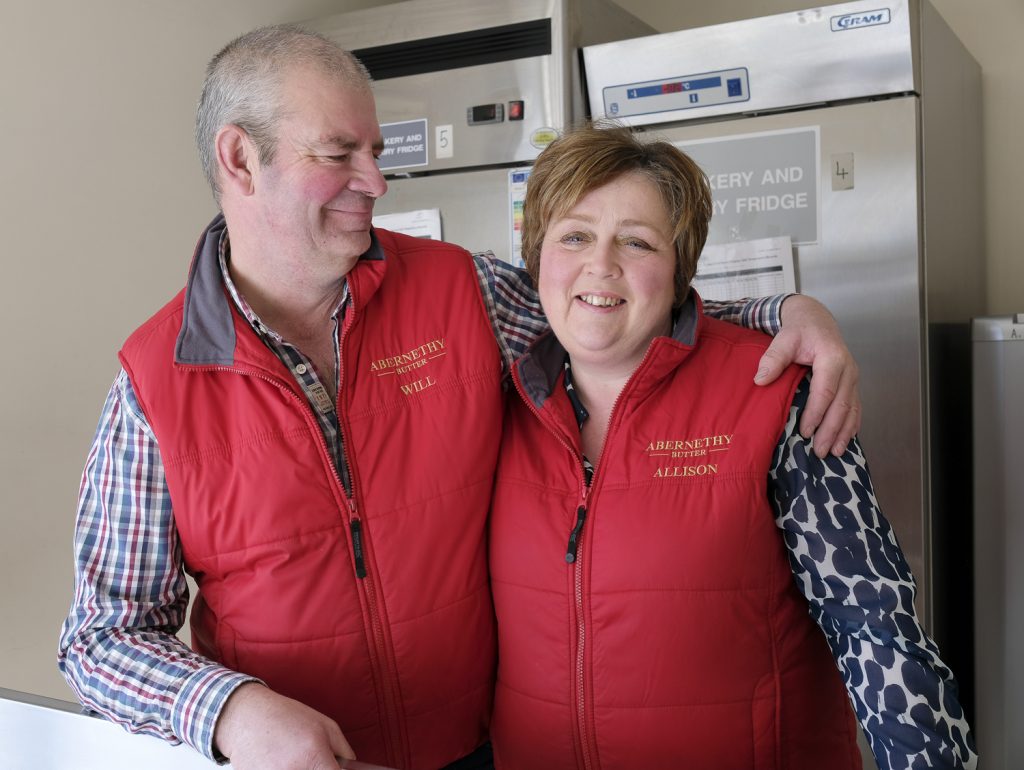
Melt the butter gently in a saucepan and set aside. Add a pinch of cayenne pepper and two or three dashes of Tabasco – don’t add too much or it will overpower the delicate flavour of the crab.
Season the crab meat with salt and pepper and mix with 1 tablespoon of the melted butter. Divide the crab between two to four ramekins and pour over the remaining melted butter.
Chill in the fridge until the butter has set and hardened. Remove from the fridge and leave at room temperature for 1 hour before serving with toast.
Recipe by Abernethy Butter

Ballymakenny Mayan Rose potato cakes with black pudding and Brussels sprouts
Potato cakes are so versatile. They work well for brunch, lunch, supper or as a side for dinner. You can make them from scratch or plan ahead when you’re making mash for dinner to have leftovers. The Brussels sprouts can be swapped out for cabbage or kale and if you want a vegetarian version, use feta instead of black pudding. Mayan Rose potatoes cook one-third faster than most potatoes, so if you are using another variety you may need to cook them for a bit longer.
SERVES 4 TO 6
- 800g Ballymakenny Mayan Rose potatoes, unpeeled
- 100g Brussels sprouts
- 40g butter
- 40ml milk
- Sea salt and ground white pepper
- 100g black pudding, cut into cubes
- 1 egg, beaten
- 1 small bunch of fresh chives, finely chopped
- 60–100g plain flour, plus extra for dusting
- Oil, for pan-frying
- Eggs cooked any way you like, to serve
- Relish, to serve
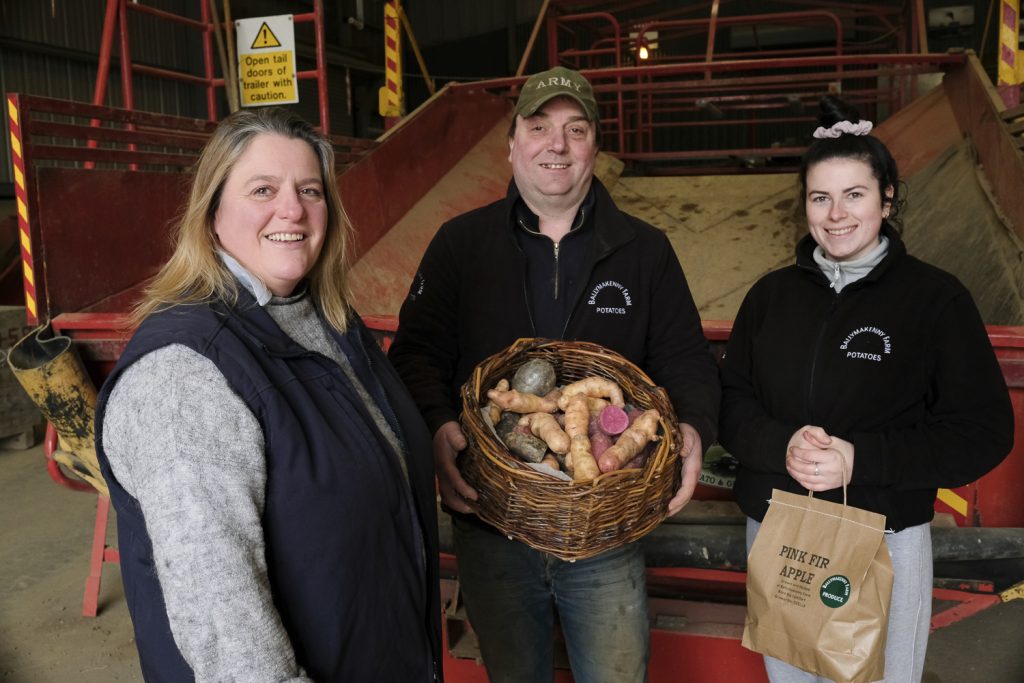
Put your potatoes in a large saucepan and cover with cold water. Add a generous pinch of salt and bring to the boil. Reduce the heat so it’s not boiling too vigorously and cook for 10 minutes. Pour off some water, cover the pan with a lid and cook for 2 to 5 minutes more, until a knife goes through the potatoes easily.
While the potatoes are cooking, prepare your Brussels sprouts. Trim the ends and discard the outer leaves. Bring a small pot of salted water to the boil, then add the sprouts and cook for 1 to 2 minutes. Drain and cool straight away. Once they are cool enough to handle, shred them.
When the potatoes are cooked, drain and peel them straight away – the skin should come away easily with a regular knife or even a spoon. Clean kitchen or rubber gloves help here, otherwise use a clean tea towel to hold the hot potatoes as you peel them.
Put your peeled spuds in a large bowl, then mash them with a potato masher until smooth (if you have a potato ricer, use that).
Heat your butter and milk together, then add to the potatoes along with a generous seasoning of sea salt and white pepper to taste. Stir well to combine and keep mashing until you get a really smooth consistency and all the lumps are gone.
Stir in the Brussels sprouts, black pudding, beaten egg and chives. Mix well, then start to stir in the flour one spoonful at a time until the mixture is a consistency you can handle – it will be a bit sticky, but that’s okay.
Scoop out one handful of the mixture at a time (you may need to dust your hands with more flour) and shape into six to eight balls, then squash each one down into a patty using your hand or a small rolling pin until they are about 1.5cm thick. Dust with some flour and chill in the fridge until you’re ready to cook.
When you’re ready to cook the potato cakes, preheat your oven to 150°C.
Heat some oil in a large non-stick frying pan.Working in batches, add a few potato cakes and sear for 3 to 5 minutes on each side, until crisp and golden. Transfer to a baking tray to heat through and keep warm in the oven.
Meanwhile, prepare your eggs however you like to eat them – poached, fried or soft boiled all work great.
Serve the potato cakes with an egg on top and some relish on the side.
Recipe by Ali Dunworth

Spiced beef blaa
This recipe comes from Guild member Domini Kemp’s café Hatch & Sons in Dublin, where it’s long been a favourite on their menu, but it’s also an excellent way to use up leftovers at Christmastime.
- Waterford blaa
- Rapeseed mayonnaise
- Tom Durcan’s spiced beef, thinly sliced
- Coolea cheese, thinly sliced
- Onion relish
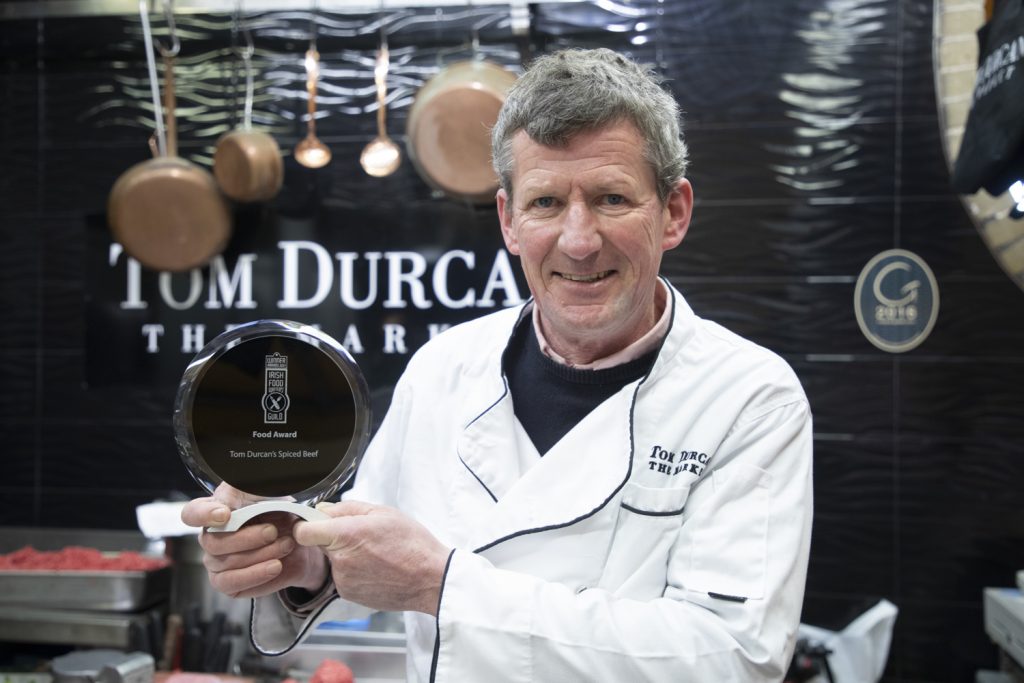
This isn’t a recipe per se, just assembly! Spread a warm blaa with rapeseed mayo, then pile on some thinly sliced spiced beef and Coolea cheese and top with a spoonful of onion relish. Sandwich together and tuck in.
Recipe by Domini Kemp

Boozy chocolate brownies with Wild Red Mead – Merlot Barrel Aged
Wild Red Mead – Merlot Barrel Aged pairs exceptionally well with good-quality chocolate, so the folks at Kinsale Mead Co. decided to experiment by adding some mead into a chocolate recipe. The results were amazing: fudgy, boozy brownies. They added walnuts from their local beekeeper’s trees, but you can leave them out or use other nuts if you choose. Kinsale Mead has many more recipes online at kinsalemeadco.ie.
MAKES 16 SMALL BROWNIES
- 60g dried cranberries (or other dried fruit of your choice)
- 175ml Wild Red Mead – Merlot Barrel Aged
- 180g dark chocolate, roughly chopped
- 115g butter, plus extra for greasing
- 3 large eggs 250g caster sugar
- 40g cocoa powder, sifted
- 150g plain flour
- 1/2 tsp salt
- 60g walnuts, toasted and chopped (optional)
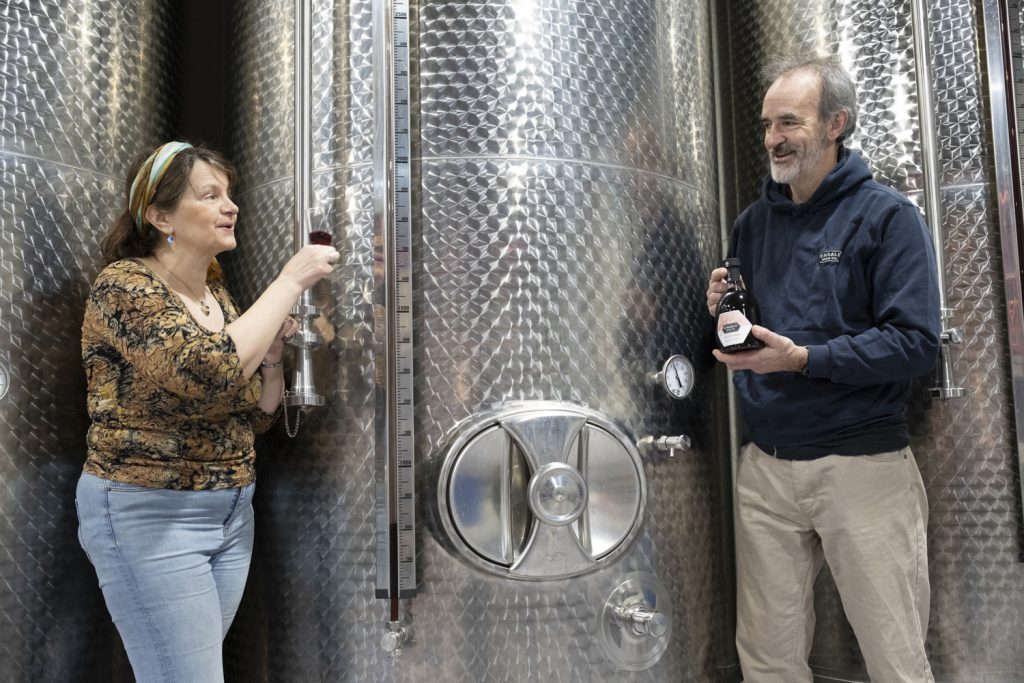
Soak the cranberries or dried fruit for at least 30 minutes in the mead, until the fruit plumps up.
Preheat the oven to 170°C. Grease a 20cm square brownie and line with non-stick baking paper.
Melt the chocolate and butter together in a heatproof bowl set over a pan of simmering water. Don’t let the bottom of the bowl touch the water. Remove from the heat and allow to cool slightly, then beat in the eggs one at a time.
Add the sugar and cocoa powder and stir to combine, then add the flour and salt and mix well. Mix in the cranberries and mead, then fold in the walnuts (if using).
Pour the mixture into the prepared brownie tin and bake in the preheated oven for 22–25 minutes, until a knife inserted into the centre comes out with small fudgy crumbs on it.
Remove the tin from the oven and cool it rapidly in a baking tray of cold water. This preserves the fudgy centre and stops the brownies from overcooking.
Cool in the tray before cutting, then cut into small pieces so they last longer – theoretically! Serve with a generous glass of Wild Red Mead – Merlot Barrel Aged.
Recipe by Kinsale Mead

Bollito
Jack Crotty spends a lot of time in Italy and his recipe, typical of Bologna, has an honest frugality that embodies some of NeighbourFood’s ethos and fits with his appreciation of local traditions. Once you spend a little time roasting the beef bones and making a good broth, you get three meals out of it and great stock for the freezer. In Italy they tend to use meat that has little fat, even in the cheaper cuts, as animals are bred to be lean. So while they use a chunk of topside, which will have some marbling, it will have no lumps of fat. In Ireland we can use cheap cuts such as beef shin, which is also delicious. The broth is used first for the bollito (a boiled meat dish), then the next dish will be a bowl of the broth with tortellini or ravioli and the last one will be a mug of warming broth to drink or use as a base for soup.
SERVES 6
- 2kg beef bones, ideally with marrow
- 2 large onions, unpeeled and halved
- 2 large carrots, unpeeled and halved
- 10 garlic cloves, unpeeled
- Olive oil, for roasting
- 4 litres water
- 2 celery sticks
- 6 bay leaves
- 1 tsp black peppercorns
- 1 tsp juniper berries
- 1 tsp allspice berries (optional)
- A handful of fresh thyme, rosemary and/or parsley stalks
- 1kg joint of topside beef or beef shin
OPTIONAL EXTRAS:
- Sausages (beef or pork)
- Diced pork or chicken
TO SERVE:
- Mustard
- Horseradish
- Mayonnaise
- Asian sauces
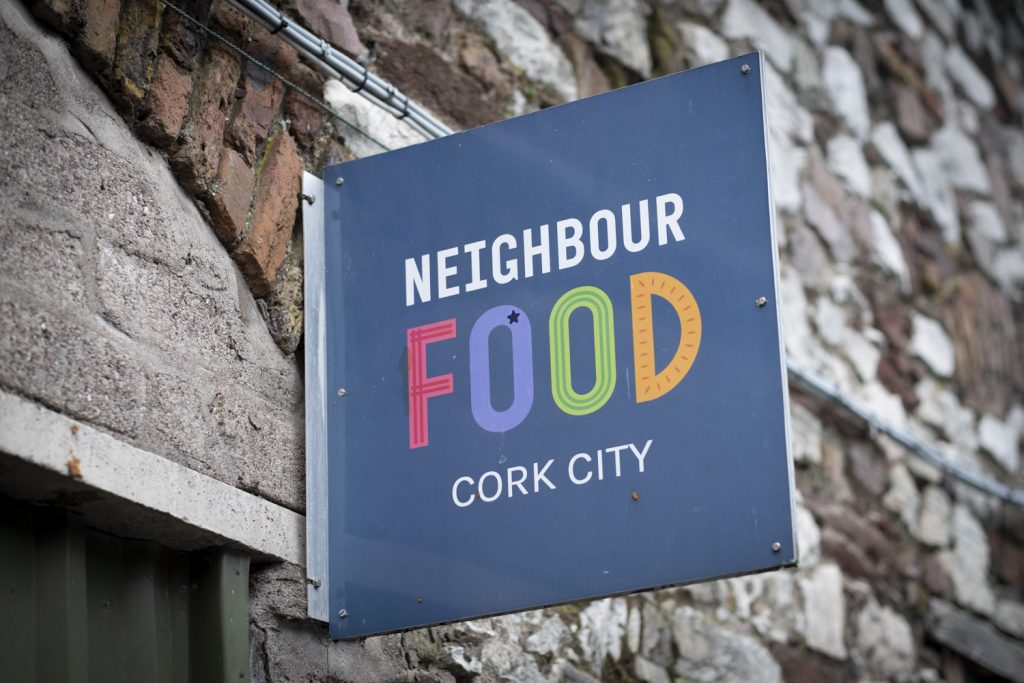
Ask your butcher for bones for stock. He or she may also give you scraps of meat when you explain what it’s for. In Ireland if you use shin of beef or flank it will be on the bone, so get the butcher to remove the meat but make sure to also come home with the bones.
Preheat the oven to 200°C.
Place the beef bones in a large roasting tray with the onions, carrots and whole garlic cloves pressed with the back of a knife to release their flavour. Drizzle with a little olive oil, then roast in the preheated oven for 45 minutes, until the bones have browned.
Remove the bones to a large stock pot, discarding any fat, and cover with the water. Add the celery, bay leaves, peppercorns, juniper berries, allspice berries (if using) and the fresh herbs you’re using. Cover the pot and bring almost to the boil, then remove the lid, reduce the heat to the very lowest setting and cook gently for 4 to 5 hours, until reduced by about one-third. Don’t allow the stock to boil at any stage. Skim off any obvious fat – this is easier if you let it cool first.
Add the joint of meat, left whole, and cook for 2 to 3 hours, until the meat is tender. For the last 40 minutes of cooking, add the sausages, diced pork or chicken (if using) – there is no need to brown them first.
Remove the beef from the stock, cut it into slices and arrange on a serving plate. Remove the sausages, pork or chicken (if using) to the serving plate too. Serve with a pot of mustard, horseradish, mayonnaise, Asian sauces or whatever is to hand.
For a second meal, skim off any fat, strain the stock and return it to the pot to reheat. Add tortellini, ravioli, plain pasta (such as the recipe for Ballymore Organics fresh pasta) or noodles and cook through, then ladle a little of the broth into a bowl, add the pasta and serve.
Enjoy the remaining stock as a warming drink. It will have thickened slightly from the starch in the pasta and cooled to a beautiful jelly. Or you can use it as a base for soups, tasting as you go and topping up with water if it becomes too intense. The broth also freezes well.
Recipe by Jack Crotty of Neighbourfood

Ballymore Organics fresh pasta
When simple ingredients are this good, there’s no need for an elaborate sauce. Serve with wild garlic pesto, brown butter and lemon, some grated Killeen Farmhouse Cheese or in the bollito broth.
SERVES 4
- 150g Ballymore Organics stone- ground plain flour, plus extra for kneading
- 150g Ballymore Organics stone- ground semolina, plus extra for rolling
- 3 medium eggs, beaten

Place the flour and semolina in a mixing bowl and whisk together. Make a well in the centre and pour the beaten eggs into it. Mix with a wooden spoon until everything is roughly combined.
Tip the dough out onto a lightly floured surface and knead for 10 to 15 minutes, until it becomes smooth and springy.
Cover with cling film and leave to rest for 30 minutes.
Clamp a pasta machine to a clean work surface and dust the area with a little semolina. Taking one-third of the dough at a time, work it through the pasta machine, feeding it through the widest to the narrowest setting according to the kind of pasta that you want to make.
For long pasta like tagliatelle, linguini or pappardelle, slice into lengths, dust with a little more semolina and allow to air dry.
Cook in a large saucepan of boiling salted water for 3 to 5 minutes, until al dente, then toss with your chosen sauce and serve straight away.
Recipe by Caroline Hennessy

Rice paper rolls with dipping sauce
Over the course of the Green-Schools Food and Biodiversity Theme pilot, we trialled and cooked many different recipes with the children and this was always a firm favourite. At the beginning of the cooking workshop we would visit the school garden and pick whatever herbs, lettuce leaves and carrots that were available, then after giving everything a good scrub, get chopping and preparing. The tactility of rolling the damp, warm rice paper discs and stuffing them full of edible plants that the children had grown always led to a certain excitement and they tend to get eaten up very quickly.
MAKES 8 ROLLS
- 50g thin rice noodles
- 1 bunch of fresh mint
- 1 bunch of fresh coriander
- 2 medium-sized carrots
- 8 lettuce leaves
- 8 rice paper discs
FOR THE DIPPING SAUCE:
- 1 tbsp soy sauce
- 1 tbsp sesame oil
- 1 tsp honey
- 1/4 tsp crushed black pepper
- 1 garlic clove (optional)
YOU WILL NEED:
- Measuring spoons
- 1 small bowl
- Mixing spoon
- Garlic press (optional)
- Kettle (or a pan and hob)
- 2 large heatproof bowls
- Colander
- Chopping board
- Chopping knife
- Potato peeler
- Clean tea towel
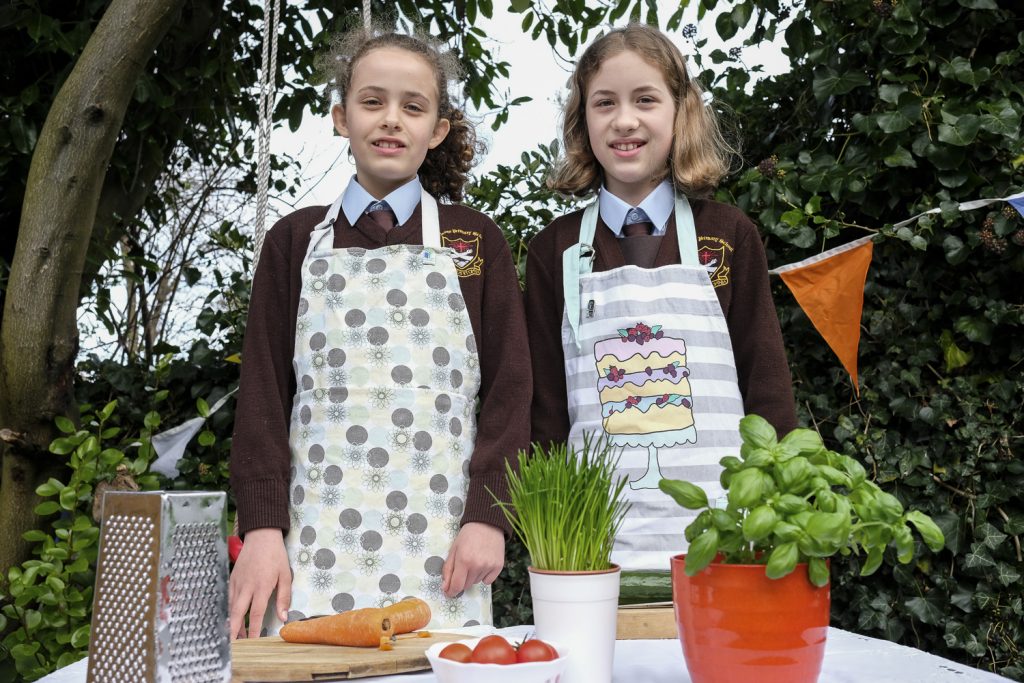
Wash your hands and dry them well.
To make the dipping sauce, use the measuring spoons to measure the soy sauce, sesame oil and honey into a small bowl. Stir it really well so that the honey mixes in evenly, then stir in the crushed black pepper. If you are using the garlic, peel the clove and crush it with your garlic press, then add to your dip and stir it in. Set the dip aside.
Boil some water in a kettle or in a pot on the hob and pour it into a heatproof bowl. Soak the rice noodles in the hot water for 15 minutes. Drain in the colander and set aside.
Wash and chop the mint and coriander. Scrub the carrots, then thinly slice them into ribbons – a potato peeler will work best. Tear the lettuce into small strips with your hands.
Pour some hot (but not boiling) water into a large heatproof bowl. Dip one rice paper disc into the hot water for 10 to 15 seconds, moving it around until it is soft all over, then place it on a clean tea towel to dry slightly. Repeat this with the other seven discs.
Place one rice paper disc onto the chopping board and add some lettuce, carrots, mint, coriander and rice noodles in a line down the centre. Lift one edge of the disc over the filling and press it down, then roll up tightly so it looks like a sausage. Repeat with the remaining discs and serve with the soy sauce dip.
Recipe by Green-Schools

Risotto with mushrooms, asparagus and mature Killeen goats’ cheese
Marion Roeleveld says this is pure comfort food, perfect on a cold evening. She loves the combination of the mushrooms and the earthy taste of mature Killeen.
SERVES 4
- Handful of dried porcini or mixed mushrooms
- 1 bunch of asparagus
- 1.2 litres vegetable stock
- 2 tbsp olive oil
- 1 onion, finely chopped
- 350g Arborio rice
- 1 glass of dry white wine
- 100g mature Killeen goats’ cheese (e.g. Dunnes Stores Simply Better Five-Months Matured Killeen Goats’ Cheese), grated
- 25g butter
- Sea salt and freshly ground black pepper
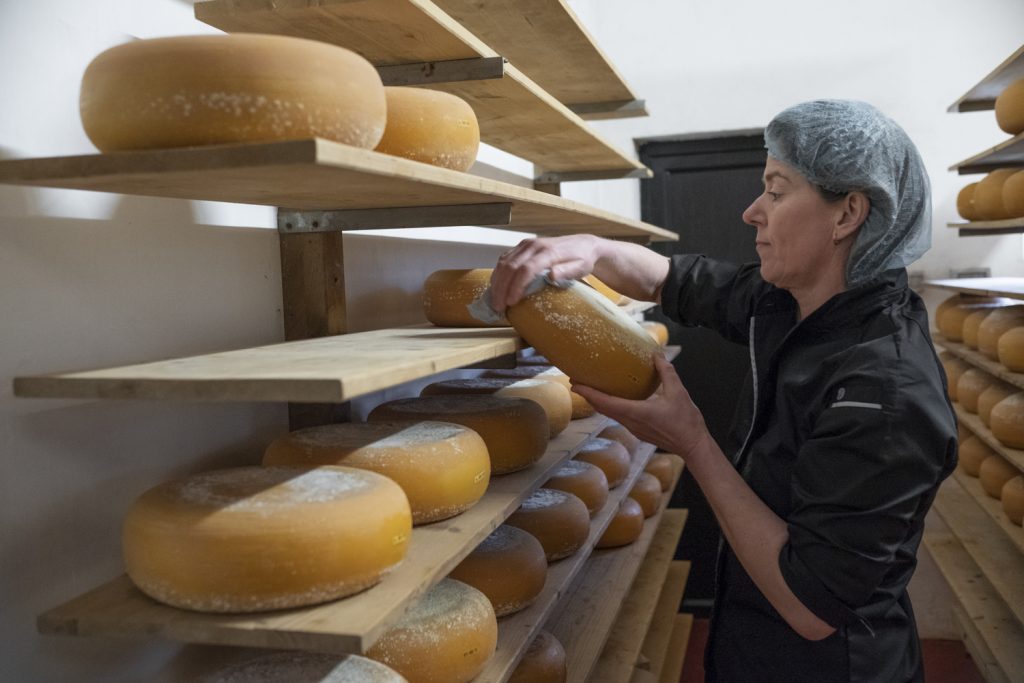
Place the dried mushrooms in a small heatproof bowl and cover with just-boiled water from the kettle. Allow to soak for 10 minutes.
Snap the woody stalks off the asparagus spears and discard, then cut the spears into 2.5cm-long pieces. Boil the asparagus for 5 minutes, then drain and set aside.
Heat the stock in a small saucepan almost to the boiling point, then reduce the heat and leave it simmering.
Heat the olive oil in a large heavy-based pan over a medium heat. Add the onion and cook gently for 5 minutes, stirring. Don’t let the onion brown.
Add the rice and give it a stir, then add the wine, reduce the heat to medium-low and keep stirring until the wine has been absorbed into the rice. Strain the liquid from the soaked mushrooms and stir it in, then chop up the soaked mushrooms and add them too.
Add the hot stock one ladle at a time, stirring until the rice has absorbed all the liquid. Keep adding more stock one ladle at a time and stirring until the rice is cooked but still has a little bite. The whole process should take 25 to 30 minutes. Just before the end, stir in the cooked asparagus.
When the risotto is cooked, take the pan off the heat and stir through half the grated cheese and all the butter. Taste and adjust the seasoning if needed.
To serve, divide the risotto between warmed shallow bowls and scatter the rest of the cheese over the top.
Recipe by Marion Roeleveld of Killeen Farmhouse Cheese




